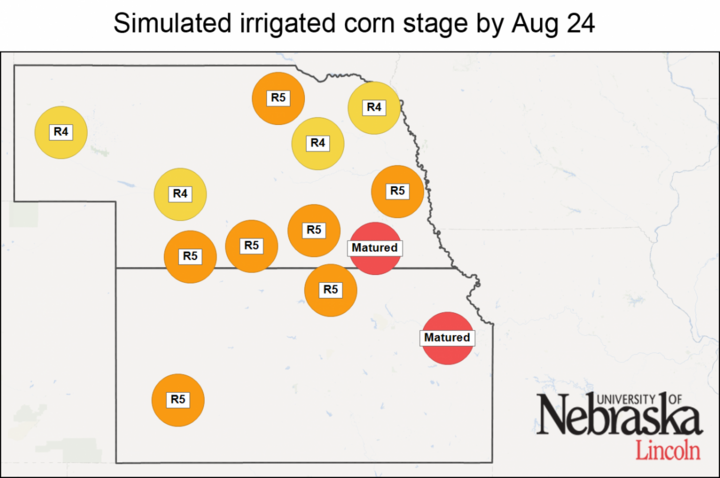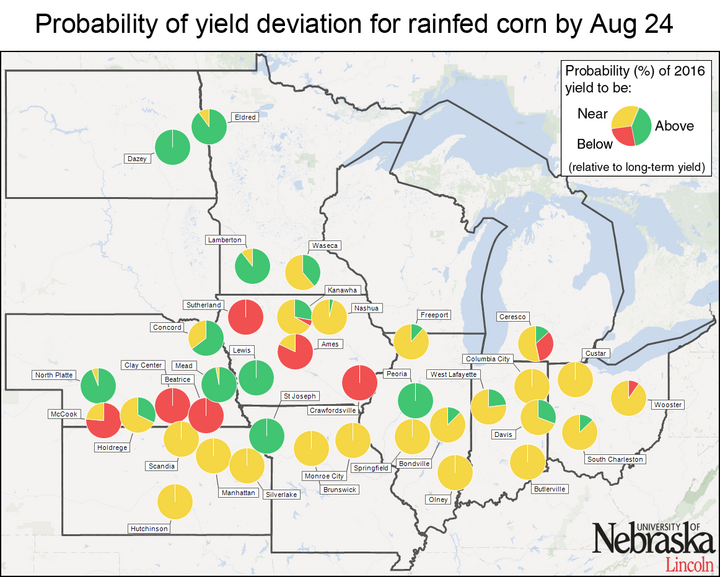
This is the fourth article in a series that summarizes the simulated crop stages and yield forecasts across a wide part of the Corn Belt. Data for the August 24 forecasts for actual and potential yields can be downloaded here. Previous corn yield forecasts for this year can be found here. Details on Hybrid-Maize and the underpinning methodology to forecast end-of-season yields, as well as on interpretation and uses of yield forecasts, are described in a previous article.
The season continued with near average temperatures during early August, except for Illinois, Indiana, Michigan, Minnesota, and Ohio (high nighttime temperatures). Rainfall was above normal in all locations, except for a number of sites with below-normal rainfall in Nebraska, Kansas, and Missouri. Weather conditions during the last two weeks are shown in Figure 1.

Figure 1. Daily solar radiation, maximum and minimum air temperature (Tmax and Tmin), total rainfall, and total reference grass-based evapotranspiration (ET) for the August 10 - 24 period. Vertical bars indicate the range for these variables based on 20+ years of weather records. The horizontal thick line indicates the long-term average and the red dots indicate 2016 values.
Simulated Corn Stage Across 41 Locations
Grain filling continues throughout Nebraska and the Corn Belt, with most corn at dough and dent stages. Physiological maturity (black layer) has been reached at most of the rainfed sites in the southern fringe of the Corn Belt (Figure 2).

Figure 2. Simulated crop development stage for irrigated and rainfed corn at each location. R3: milk; R4: dough; R5: dent; and matured (“black layer”).

Irrigated Corn: High Probability of Near-Average Yields
The range of forecasted irrigated corn yields for each location, as well as the probabilities for yields above, near or below average, are shown in Figures 3 and 4. Half of the irrigated sites exhibit a high-probability (>75%) of near-average yields. Weather conditions during the rest of the season will determine if the other half of the irrigated sites will also remain near-average yield or, instead, will achieve above-average yield. An exception is Beatrice, Nebraska, where final forecasted yield was 11% below average.

Figure 4. Probability of obtaining a 2016 yield below (≤10%, red color), near (±10%, yellow color), and above (>10%, green color) the long-term (2005-2014) average at each location. The larger a color section is within the pie chart, the higher the probability that corn yield will be in that category.

Rainfed Corn: Highly Uncertain and Variable Yield Across Locations
Ranges of forecasted yields for rainfed corn have narrowed substantially relative to the previous forecasts, indicating high probability (>75%) of near-average yield at 16 sites, that is, about half of 37 rainfed sites (Figures 3 and 4). These sites are located mainly in the southern and eastern regions of the Corn Belt. There is a high probability (>75%) of above-average yield at eight of the rainfed locations: western Nebraska (North Platte), central-east Nebraska, southeastern Iowa, and northwestern Missouri (Mead, Lewis, and St Joseph), eastern North Dakota, western Minnesota (Dazey, Eldred, and Lamberton), and central Illinois (Peoria). In contrast, there is a high probability (>75%) of below-average yield at seven sites, located in southwestern and southeastern Nebraska (McCook, Clay Center, and Beatrice), and northwestern, central, and southeastern Iowa (Crawfordsville, Ames, and Sutherland). Near- or above-average yields are expected in the remaining six rainfed sites.
State-Level Forecasted Corn Yields
Our yield forecasts were upscaled to state level using the spatial framework of the Global Yield Gap Atlas. Briefly, upscaling is performed based on agro-climatic zones and distribution of corn harvested area. Forecasted yields for 2016, for each state and water regime, are shown in Table 1. For comparison, we also show the average corn yield reported by USDA-NASS for the last 10 years. Forecasted 2016 yields fall near average in most states. Rainfed yields are slightly above-average in Nebraska, Kansas, Illinois, and Indiana (3% to 6%), below average yield in Iowa (-7%), and well above average in Minnesota (+19%).
| State* | Water regime | Forecasted 2016 yield (bu/ac)** | Average (2006-2015) yield (bu/ac)† | % deviation ‡ |
|---|---|---|---|---|
| Nebraska | Irrigated | 187 | 191 | -2% |
| Rainfed | 134 | 126 | +6% | |
| Kansas | Irrigated | 198 | 186 | +6% |
| Rainfed | 99 | 93 | +6% | |
| Iowa | Rainfed | 158 | 170 | -7% |
| Minnesota | Rainfed | 195 | 164 | +19% |
| Missouri | Rainfed | 137 | 135 | +1% |
| Illinois | Rainfed | 175 | 166 | +5% |
| Indiana | Rainfed | 161 | 156 | +3% |
| Ohio | Rainfed | 153 | 155 | -1% |
| * North Dakota and Michigan were not included in the state forecasts because we only forecasted yield for one site in each of these states. Note that uncertainty in the Minnesota statewide yield is also higher due to the small number of sites for which corn yields were forecasted. ** Based on our median 2016 forecasted actual yield estimated for each location † State 10-year (2006-2015) average yield reported by USDA-NASS (https://quickstats.nass.usda.gov/). ‡ Deviation of forecasted 2016 yield relative to average (2006-2015) yield reported by USDA. |
||||
Conclusions
In contrast to the record corn yield forecasted for 2016 by USDA NASS in early August, our forecasts do not provide clear indication of a record yield this year. Our Aug. 24 forecasts indicate a high probability of near-average corn yields for about half of the rainfed and irrigated sites. The yield scenario is still uncertain for the other half of the sites, although near- or above-average yields are likely for irrigated corn while above- and below-average yield are forecast in equal proportions for rainfed corn.
Note that these forecasts do not take into consideration problems with stand emergence, hail/flooding damage, replanting situations, disease, or nitrate leaching. Therefore, in fields negatively affected by these constraints, actual yields will be lower than estimates provided here. It is important to keep in mind that yield forecasts are not field specific and, instead, represent an estimate of average on-farm yield for a given location and surrounding area in absence of the yield-reducing factors mentioned here. Likewise, crop development stages and forecasted yields will deviate from the ones reported here in fields with planting dates or hybrid maturities that differ markedly from the ones used as basis for the forecasts. We will follow up with further forecasts in early September.
For more information contact Patricio Grassini at pgrassini2@unl.edu or 402-472-5554.